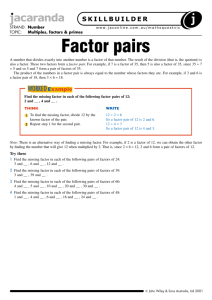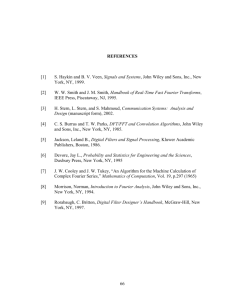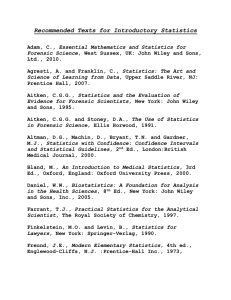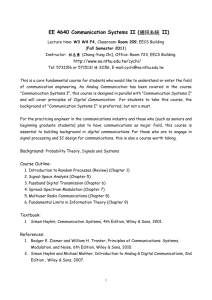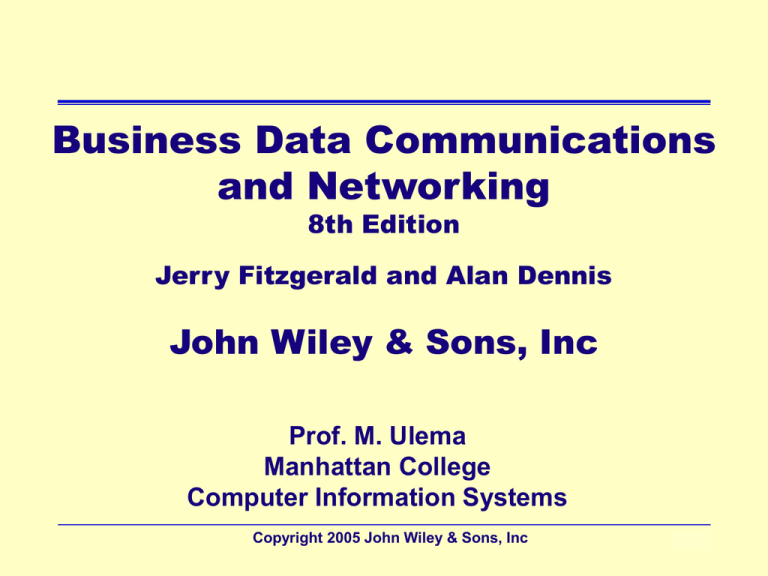
Business Data Communications
and Networking
8th Edition
Jerry Fitzgerald and Alan Dennis
John Wiley & Sons, Inc
Prof. M. Ulema
Manhattan College
Computer Information Systems
Copyright 2005 John Wiley & Sons, Inc
1-1
Chapter 1
Introduction to Data
Communications
Copyright 2005 John Wiley & Sons, Inc
1-2
Outline
• Brief history
– Communications, Information Systems and the Internet
• Data Communications Networks
– Network components, network types
• Network Models
– OSI model, Internet model, Layers
• Network Standards
– Standards making, common standards
• Future Trends
– Pervasive networking, integration of voice, video, and
data, new information services
Copyright 2005 John Wiley & Sons, Inc
1-3
Information Age
• First Industrial Revolution
– Introduction of machinery
– New organizational methods
– Changed the way people worked
• Second Industrial Revolution – Information Age
– Introduction of computers
– Introduction of networking and data communication
– Changed the way people worked again
• Faster communication Collapsing Information lag
• Brought people together Globalization
Copyright 2005 John Wiley & Sons, Inc
1-4
Collapsing Information Lag
Electronic
communications
sped up the rate of
transmission of information,
telegraph
1850
Information took
days or weeks to
be transmitted
1900
1950
Information
transmitted in
minutes or hours
growth of telecommunications and
especially computer networks
2004
huge quantities of
information
transmitted in a
fraction of a second.
globalization
phenomenon
(WWW)
Copyright 2005 John Wiley & Sons, Inc
1-5
Three Faces of Networking
• Fundamental concepts of networking
– How data moves from one computer to another over a
network
– Theories of how network operate
• Technologies in use today
– How theories are implemented, specific products
– How do they work, their use, applications
• Management of networking technologies
– Security
– Network Design
– Managing the network
Copyright 2005 John Wiley & Sons, Inc
1-6
Advances in Phone Technology
first transcontinental
and
transatlantic
Phone
phone
invented connections
1876
1915
Telstar
(Telecommunications
via satellite), Fax
services, digital
transmission (Tcarriers)
1948
1962
1976
1969
1919
Strowger (stepper)
switch,
rotary dial phones
(enabling automatic
connections)
Packet-switched
data
communications
Microwave
trunk lines
(Canada)
Picturefone
(failed
commercially)
Copyright 2005 John Wiley & Sons, Inc
1984
Cellular
telephone
1-7
Invention to Regulation
FCC established
A time for
technological
change
1876
1885
Regulation
began in the
USA (ICC)
1900
1910
1934
acceptance)
1996
1968
1984
1970
AT&T
Phone
invented (rapid
US
Telecom
Act
Carterfone court
decision allowing
non-Bell CPE
Bell System:
de facto
monopoly
millions of phones
in use in the US
Consent
decree by US
federal court
MCI wins court case;
begins providing some
long distance services
Copyright 2005 John Wiley & Sons, Inc
1-8
1984 Consent Decree
Divestiture:
• AT&T broken up into a long distance company (AT&T) & 7
Regional Bell Operating Companies (RBOCs)
South
Western
Bell
US West
AT&T
Bell Atlantic
NYNEX
Pacific Bell
AT&T
Ameritech
Bell South
Deregulation:
• Competitive long distance (IXC) market; MCI & Sprint enter LD
market (among others)
• Local Exchange Carrier (LEC) service markets remained
under RBOC monopoly
Copyright 2005 John Wiley & Sons, Inc
1-9
US Telecom Act of 1996
• Replaced all current laws, FCC
regulations, 1984 consent decree, and
overrules state laws
• Main goal: open local markets to
competition
• To date, though, local competition slow to
take hold…
– Large IXCs expected to move into the local
markets, happening only recently
– Likewise, RBOCs expected to move into long
distance markets, happening only recently
Copyright 2005 John Wiley & Sons, Inc
1 - 10
Worldwide Competitive Markets
• Internet market
– Extremely competitive with more than 5000 Internet
Service Providers (ISPs) in the US alone.
– Heavy competition in this area may lead to a shake out
in the near future.
• World Trade Organization (WTO) agreement
(1997)
– commitments by 68 countries to open, deregulate or
lessen regulation in their telecom markets
• Multi-national telecom companies
– US companies offering services in Europe, South
America
– European companies offering services in USA
Copyright 2005 John Wiley & Sons, Inc
1 - 11
History of Information Systems
Online real-time,
transaction oriented
systems (replaced batch
processing. DBMSs
become common)
Batch
processing
mainframes
1950
1960
1970
Data communications over
phone lines (became
common and mainframes
became multi-user systems)
1980
PC LANs
become
common
1990
2000
PC revolution
Copyright 2005 John Wiley & Sons, Inc
Networking
everywhere
1 - 12
Internet Milestones
Originally called
ARPANET, the Internet
began as a militaryacademic network
1969
1983
NSFNet
created as
US Internet
backbone
1986
ARPANET splits:
• Milnet - for military
• Internet - academic,
education and research
purposes only
commercial
access to
the Internet
begins
1990
1994
Government
funding of the
backbone
ends
Copyright 2005 John Wiley & Sons, Inc
2001
Over 240
million
servers
and 400
million
users
1 - 13
Datacom Basics
Telecommunications
transmission of voice, video, data,
- imply longer distances
- broader term
Data Communications
movement of computer information
by means of electrical or optical
transmission systems
convergence
Broadband Communications
Copyright 2005 John Wiley & Sons, Inc
1 - 14
Components of a Local Area Network
To other networks
(e.g., Internet)
Router
Servers
File
Server
HUB
Client
Web
Server
Computers
Circuits
Print
Server
Printer
Copyright 2005 John Wiley & Sons, Inc
1 - 15
Network Types (based on Scale)
• Local Area Networks (LANs) - room, building
– a group of PCs that share a circuit.
• Backbone Networks - less than few kms
– a high speed backbone linking the LANs at various locations.
• Metropolitan Area Networks (MAN) - (< few 10
kms)
– connects LANs and BNs at different locations
– leased lines or other services used to transmit data.
• Wide Area Networks (WANs) - (> few 10 kms)
– Same as MAN except wider scale
Copyright 2005 John Wiley & Sons, Inc
1 - 16
LAN vs. BN vs. MAN vs. WAN
Figure 1.2 goes here
Copyright 2005 John Wiley & Sons, Inc
1 - 17
Intranet vs. Extranet
• Intranet
– A LAN that uses the Internet technologies
– Open only those inside the organization
– Example: insurance related information provided to
employees over an intranet
• Extranet
– A LAN that uses the Internet technologies
– Open only those invited users outside the organization
– Accessible through the Internet
– Example: Suppliers and customers accessing inventory
information in a company over an extranet
Copyright 2005 John Wiley & Sons, Inc
1 - 18
Implementation of
Communications Functions
Applications
OS
Applications
OS
Single
layer
implementation
Applications
OS
Applications
OS
Multi layer
implementation
-Breaking down into
smaller components
-Easier to implement
Copyright 2005 John Wiley & Sons, Inc
1 - 19
Multi-layer Network Models
• The two most important such network models:
OSI and Internet
• Open Systems Interconnection Model
– Created by International Standards Organization (ISO)
as a framework for computer network standards in 1984
– Based on 7 layers
• Internet Model
–
–
–
–
Created by DARPA originally in early 70’s
Developed to solve to the problem of internetworking
Based on 5 layers
Based on Transmission Control Protocol/ Internet
Protocol (TCP/IP) suite
Copyright 2005 John Wiley & Sons, Inc
1 - 20
7-Layer Model of OSI
Physical DataLink Network Transport Session Presentation Application
Please Do Not Touch Steve’s Pet Alligator
• Application Layer
– set of utilities used by application programs
• Presentation Layer
– formats data for presentation to the user
– provides data interfaces, data compression and
translation between different data formats
• Session Layer
– initiates, maintains and terminates each logical session
between sender and receiver
Copyright 2005 John Wiley & Sons, Inc
1 - 21
7-Layer Model of OSI
• Transport Layer
– deals with end-to-end issues such as segmenting the
message for network transport, and maintaining the
logical connections between sender and receiver
• Network Layer
– responsible for making routing decisions
• Data Link Layer
– deals with message delineation, error control and
network medium access control
• Physical Layer
– defines how individual bits are formatted to be
transmitted through the network
Copyright 2005 John Wiley & Sons, Inc
1 - 22
Internet’s 5-Layer Model
Physical DataLink Network Transport Application
Please Do Not Touch Alligator
• Application Layer
– used by application program
• Transport Layer
– responsible for establishing end-to-end connections,
translates domain names into numeric addresses and
segments messages
• Network Layer - same as in OSI model
• Data Link Layer - same as in OSI model
• Physical Layer - same as in OSI model
*
Copyright 2005 John Wiley & Sons, Inc
1 - 23
Comparison of Network Models
Copyright 2005 John Wiley & Sons, Inc
1 - 24
Message Transmission Using Layers
sender
receiver
Applications
Applications
A receiving layer
wraps incoming
message with an
envelope
A receiving layer
removes the
layer related
envelope and
forwards the
message up
• Adds layer
related
addressing
information
Copyright 2005 John Wiley & Sons, Inc
1 - 25
Protocols
• Used by Network model layers
• Sets of rules to define how to
communicate at each layer and how to
interface with adjacent layers
Layer N+1
Layer N+1
Layer N
Layer N
Layer N-1
Layer N-1
sender
receiver
Copyright 2005 John Wiley & Sons, Inc
1 - 26
Message Transmission Example
Copyright 2005 John Wiley & Sons, Inc
1 - 27
Important Points to Observe
• Many different software packages (protocols) and
many different packets (at different layers)
– Easy to develop new software
– Simple to change the software at any level
• Matching layers communicate at different
computers
– Accomplished by standards
– e.g., Physical layer at the sending computer must be
the same in the receiving computer
• Somewhat inefficient
– Involves many software layers and packet types
– Packet overhead (slower transmission, processing time)
Copyright 2005 John Wiley & Sons, Inc
1 - 28
Standards
• Importance
– Provide a “fixed” way for hardware and/or software
systems (different companies) to communicate
– Help promote competition and decrease the price
• Types of Standards
– Formal standards
• Developed by an industry or government standardsmaking body
– De-facto standards
• Emerge in the marketplace and widely used
• Lack official backing by a standards-making body
Copyright 2005 John Wiley & Sons, Inc
1 - 29
Standardization Processes
• Specification
– Developing the nomenclature and identifying
the problems to be addressed
• Identification of choices
– Identifying solutions to the problems and
choose the “optimum” solution
• Acceptance
– Defining the solution, getting it recognized by
industry so that a uniform solution is accepted
Copyright 2005 John Wiley & Sons, Inc
1 - 30
Major Standards Bodies
• ISO (International Organization for
Standardization)
– Technical recommendations for data communication
interfaces
– Composed of each country’s national standards orgs.
– Based in Geneva, Switzerland (www.iso.ch)
• ITU-T (International Telecommunications Union –
Telecom Group
– Technical recommendations about telephone, telegraph
and data communications interfaces
– Composed of representatives from each country in UN
– Based in Geneva, Switzerland (www.itu.int)
Copyright 2005 John Wiley & Sons, Inc
1 - 31
Major Standards Bodies (Cont.)
• ANSI (American National Standards Institute)
– Coordinating organization for US (not a standardsmaking body)
– www.ansi.org
• IEEE (Institute of Electrical and Electronic
Engineers)
– Professional society; also develops mostly LAN
standards
– standards.ieee.org
• IETF (Internet Engineering Task Force)
– Develops Internet standards
– No official membership (anyone welcomes)
– www.ietf.org
Copyright 2005 John Wiley & Sons, Inc
1 - 32
Some Data Comm. Standards
Layer
Common Standards
5. Application layer
HTTP, HTML (Web)
MPEG, H.323 (audio/video)
IMAP, POP (e-mail)
4. Transport layer
TCP (Internet)
SPX (Novell LANs)
3. Network layer
IP (Internet)
IPX (Novell LANs)
2. Data link layer
1. Physical layer
Ethernet (LAN)
Frame Relay (WAN)
PPP (dial-up via modem for MAN)
RS-232c cable (LAN)
Category 5 twisted pair (LAN)
V.92 (56 kbps modem)
Copyright 2005 John Wiley & Sons, Inc
1 - 33
Emerging Trends in Networking
• Pervasive Networking
• Integration of Voice, Video and Data
• New Information Services
Copyright 2005 John Wiley & Sons, Inc
1 - 34
Pervasive Networking
• Means “Network access everywhere”
• Exponential growth of Network use
• Many new types of devices will have
network capability
• Exponential growth of data rates for all
kinds of networking
• Broadband communications
– Use circuits with 1 Mbps or higher (e.g., DSL)
Copyright 2005 John Wiley & Sons, Inc
1 - 35
Relative Capacities of Telephone, LAN,
BN, WAN, and Internet Circuits.
Copyright 2005 John Wiley & Sons, Inc
1 - 36
Integration of Voice, Video & Data
• Also called “Convergence”
– Networks that were previously transmitted
using separate networks will merge into a
single, high speed, multimedia network in the
near future
• First step (already underway)
– Integration of voice and data
• Next Step
– Video merging with voice and data
– Will take longer partly due to the high data
rates required for video
Copyright 2005 John Wiley & Sons, Inc
1 - 37
New Information Services
• World Wide Web based
– Many new types of information services becoming
available
• Services that help ensure quality of information
received over www
• Application Service Providers (ASPs)
– Develop specific systems for companies
• Providing and operating a payroll system for a
company that does not have one of its own
• Information Utilities (Future of ASPs)
– Providing a wide range of info services (email, web,
payroll, etc.) (similar to electric or water utilities)
Copyright 2005 John Wiley & Sons, Inc
1 - 38
Implications for Management
• Embrace change and actively seek to apply
networks to improve what you do
– Information moved quickly and easily anywhere and
anytime
– Information accessed by customers and competitors
globally
• Use a set of industry standard technologies
– Can easily mix and match equipment from different
vendors
– Easier to migrate from older technologies to newer
technologies
– Smaller cost by using a few well known standards
Copyright 2005 John Wiley & Sons, Inc
1 - 39
Copyright 2005 John Wiley & Sons, Inc.
All rights reserved. Reproduction or translation of
this work beyond that permitted in section 117 of
the 1976 United States Copyright Act without
express permission of the copyright owner is
unlawful. Request for further information should
be addressed to the Permissions Department,
John Wiley & Sons, Inc. The purchaser may make
back-up copies for his/her own use only and not
for distribution or resale. The Publisher assumes
no responsibility for errors, omissions, or
damages caused by the use of these programs or
from the use of the information herein.
Copyright 2005 John Wiley & Sons, Inc
1 - 40

